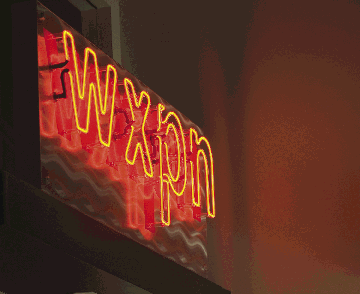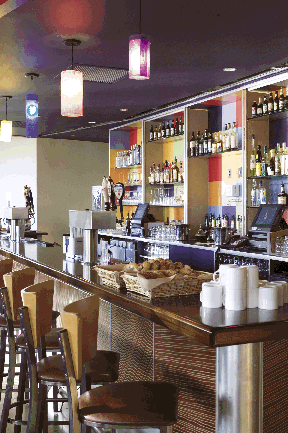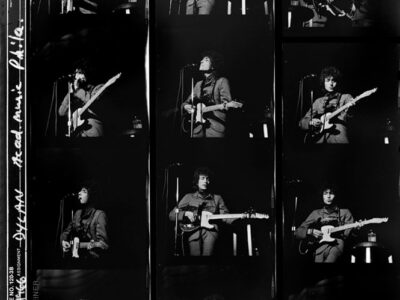
A new home for WXPN and an upscale “clubhouse” for its fans.
Sometimes when he’s on the air, David Dye, the veteran DJ and host of the World Café radio show, will look up and notice the visitors, noses pressed against the thick soundproof glass of his studio, watching him as he spins CDs and interviews guest musicians. He’s pretty used to it by now, which is a good thing, since there are a lot more visitors touring the WXPN studios now that Penn’s public-radio station has moved to its handsome new digs at 3025 Walnut St. Though it’s only about 11 blocks away from the station’s old red-brick home at 3905 Spruce St. (which was built in the 19th century as a private residence), in terms of style and practicality, it’s a quantum leap forward.

“It’s been interesting just watching the evolution,” says Dye. “I remember thinking: ‘People are going to come—is this place going to be how we want it to be, and therefore a good, symbiotic thing for us?’ And I’ve just kind of watched it bloom.”
A year ago, bloom might have seemed an unlikely word to use for the old Hajoca building, which sits beside the western end of the Walnut Street bridge connecting West Philadelphia to Center City. The 40,000-square-foot building looked very much like the abandoned manufacturing facility that it was, and it took a lot of work, imagination, and money (none spent by the University) to bring that grimy old plant to life. But since it opened this past October, 3025 Walnut is suddenly a veryhappening address.
That’s partly because of the symbiosis Dye alludes to, which is between ’XPN’s studios and a unique, upscale “clubhouse” called World Café Live. Though separately owned and managed, they are entwined by proximity, business contracts, and a zeal for the kind of music that WXPN plays. (That style is known in the business as AAA—Adult Album Alternative—a deadening way to describe a mix that runs the gamut from the Neville Brothers to Lucinda Williams to Elvis Costello.)

That clubhouse features, among other things, Downstairs at World Café Live, a three-tiered music hall that can seat from 350 people (“bistro style”) to 700 (standing-room only), and Upstairs, a street-level café that can seat about 100, offers live radio broadcasts and live music, and serves food and drink until the small hours of the morning. (At a recent Gospel Brunch, for example, the Dixie Hummingbirds belted out some gut-tickling gospel numbers on the Downstairs stage while the audience of about 150 dug into ham-and-cheese omelets, chicken gumbo, and Mimosas.) It also has Green Rooms for travel-weary performers and retail areas for selling tickets, CDs, T-shirts, and logo merchandise. At the risk of sounding boosterish, it’s a pretty cool place.
So, from a more technical point of view, is the WXPN side of the equation. At the heart of it is the deluxe 1,000 square-foot studio with custom acoustic treatments capable of handling large bands and audience seating. (“Musicians are uniformly knocked out,” says Dye. “And it’s so much easier to get a good sound.”) There are several other studios that can be made accessible to the public, as well as climate-controlled archives, conference rooms, and office space—not to mention some terrific murals and a “technology distribution center” that, according to a press release, “provides the central digital backbone and equipment control point necessary for a modern radio and audio-production facility.”
The combined ventures are already becoming “bigger than the sum of the two parts,” in Dye’s words. “It’s sort of a destination to come here, but once you come here, there’s a lot to do.”
“We thought about the fact that we were going to be in this high-profile public location and have this open-to-the-public venue, so we really embraced the idea of making the inside of it very public-friendly,” says Roger LaMay G’99, WXPN’s general manager, who took over the project in mid-stream after former GM Vinnie Curran left to take a job with the Corporation for Public Broadcasting in 2002. “We thought about it in terms of design. We have tours four days a week, and people are showing up every day. It’s the whole picture of, ‘This is your radio station’—it’s meant to be accessible.
“Clearly, within the mission of the University is to bring in very talented, creative people, to come in and have the students exposed to them; to have the staff, faculty, and alumni exposed to it; to have the community exposed to them,” LaMay adds. “And this furthers that mission in a great way. What gets people into the building also makes us far more part of a community.” That community, LeMay notes, includes “over 150 students involved with the station in one way, shape, or form.”
The idea for this dream union came from a WXPN aficionado named Hal Real, a lawyer and entrepreneur whose Real Entertainment Group financed and operates the clubhouse side of the equation. Real Entertainment also pays WXPN an annual stipend for the right to use the name of its flagship program, which is syndicated to more than 160 stations around the country.
The station has raised $4 million from its listener base and friends; the bigger donors have their names enshrined on oversized CDs hanging in a section known as Donor Alley. Real Entertainment kicked in another $4.5 million. And Carl Dranoff, the project’s developer (who also built the nearby Left Bank apartment building), contributed $8 million.
The task of converting an aging plumbing-supplies plant into two discrete, multi-use, acoustically top-drawer sound halls was a daunting challenge from an architectural viewpoint, and bears the imprint of three different firms. Bower Lewis Thrower Architects designed the overall building renovation; Meyer Associates designed the offices and studios for WXPN; and DAS Architects designed the performance and dining areas of World Café Live. The sound, light, and video systems were designed by Clair Brothers, whose credits include the systems-design for The Late Show with David Letterman.
It’s hard to overemphasize the importance of the acoustic isolation, as LaMay puts it. “Not only do we have the urban environment and the train track going outside, but within the building, to have a radio station and our studio over here and the venue right across the hall, all the stuff had to be isolated from each other so that one could be really loud and one could be really soft. Hal and I spent an awful lot of money to make that happen—and it’s worked. It’s great.”
“One of the first things we recorded live at World Café Live was the Neville Brothers,” says Dye. “And there were like nine pieces on stage. And we never, in a million years, could have done it” at the station’s old home—where the studio space was so small that several members of Lyle Lovett’s large band had to play out in the hallway. Nor would WXPN have been able to get a decent recording of a “really loud band” like the Jon Spencer Blues Explosion.
“In the past, we would have these things done from New York,” Dye adds. “We have a relationship with Sirius satellite radio, and they own a studio and we use it up there. I’m thinking that we are going to see more of those people come down here.”
Owners of some small music venues around Philadelphia, such as the Tin Angel in Old City, have publicly complained that WXPN has given itself a big competitive advantage by opening a performance venue next to its studios, where some of the genre’s most popular artists are eager to perform on radio. LaMay acknowledges the complaints, but notes that the station continues to promote and host events at other venues around town, and that Downstairs at the World Café Live fills a void in the city’s roster of live-music venues.
“We’ve made an absolute mission out of the fact that we’re going to continue to work with everybody,” he says. “We’re going to try to be even-handed. But I think the more important issue here is that this place holds 300 in its smallest configuration. There’s no place this size in town. It fits between the coffee houses and the bigger places. There are all these artists that were forced to play at the Tin Angel, to the point where there were double shows because there was no place else for them to play. So it really fills a gap in town. And I’ve never heard an audience member or an artist walk into the venue here and say, ‘This is a bad thing for Philadelphia.’”
In LaMay’s view, it’s a good thing for Penn, too. “One thing that ’XPN does for Penn is, it’s a great outreach tool, and it connects a lot of people to the region,” he says. “World Café nationally gets the name of Penn out there with 165-plus stations across the country. So it’s a good marketing thing. I saw a couple years ago that one of the ways in which Penn markets itself is as the ‘hip, social Ivy.’ Well, ’XPN is certainly a real asset on that side.”
The 65,000 drivers who ply the Schuylkill Expressway each day can see a large neon sign with WXPN’s call letters, and the station and World Café Live are also in easy view of the cars and pedestrians who cross the Walnut Street Bridge. WXPN, as LaMay points out, is thus a highly visible “beachhead” in Penn’s eastern expansion.
“We’re on the bridge,” says LaMay. “People cross the bridge; it’s very easy to come here, and my attitude is—and the University’s focused on this—once you’ve come this far, it’s a lot easier to get them to come the rest of the way, so there’s a whole initiative out there, with a huge marketing campaign, for promoting arts and culture at Penn. And I think this is the key spot in that.”
“It seemed like it took forever,” says Dye. “Then all of a sudden it’s here and it’s one of those rare instances when, even though you’ve hyped it and talked about it forever, it turns out better than you thought it was going to be.”—S.H.




